The crisis of 1943
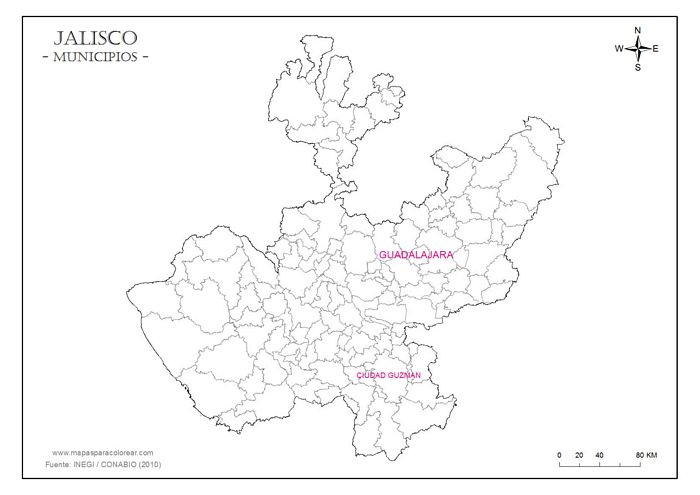 In 1943, during the Second World War, Mexico was again faced with a silver crisis. A combination of reasons - anticipation of a rise in the price of silver; the Mexican government’s agreement to sell practically its entire silver production to the United States for its military industry; and a boom in the Mexican and US jewellery industries - caused the price of silver to rise and silver coins to be hoarded. On 21 August Mexico imposed a heavy export tax on silver products, to make it unprofitable to melt down silver coins to ship as bullion, and temporarily suspended a contract which promised all surplus silver production to the United States. However because of a shortage of fractional coinage, especially the fifty centavos denomination, it was compelled to authorise banks to issue cheques with printed denominations of twenty-five and fifty centavos. while it arranged for the production of new coins.
In 1943, during the Second World War, Mexico was again faced with a silver crisis. A combination of reasons - anticipation of a rise in the price of silver; the Mexican government’s agreement to sell practically its entire silver production to the United States for its military industry; and a boom in the Mexican and US jewellery industries - caused the price of silver to rise and silver coins to be hoarded. On 21 August Mexico imposed a heavy export tax on silver products, to make it unprofitable to melt down silver coins to ship as bullion, and temporarily suspended a contract which promised all surplus silver production to the United States. However because of a shortage of fractional coinage, especially the fifty centavos denomination, it was compelled to authorise banks to issue cheques with printed denominations of twenty-five and fifty centavos. while it arranged for the production of new coins.
Guadalajara
Cámara Nacional de Comercio
By 29 August the shortages had become so severe that some merchants were thinking of issuing 50c cheques but were hampered by the lack of chequebooksEl Informador, Año XXVI, Tomo LCV, Núm. 9004, 29 August 1943.
On 17 September the local Cámara Nacional de Comercio issued a group of identical 50c cheques, drawn on five local banks: the Banco Nacional de México, S. A. Sucursal en Guadalajara; the Banco Refaccionario de Jalisco, S. A., the Banco Industrial de Jalisco, S. A., the Banco Mercantil de Guadalajara, S. A. and the Banco Provincial de Jalisco, S. A.
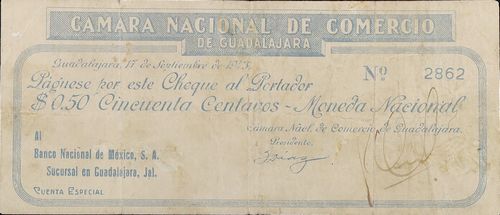
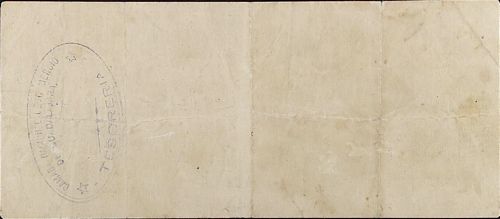
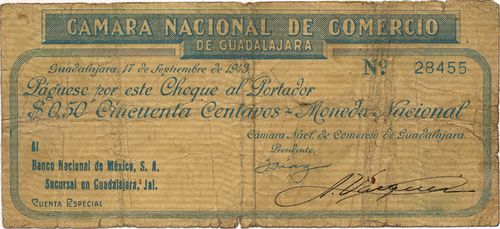
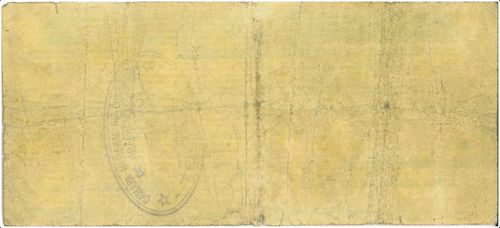
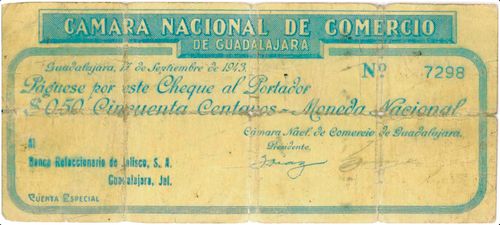
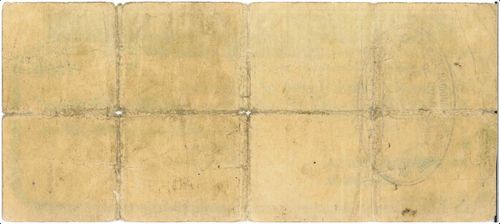
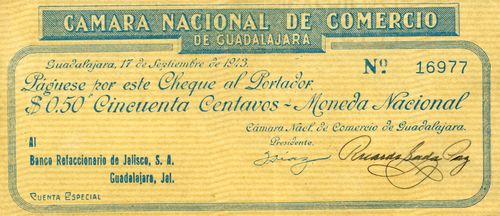
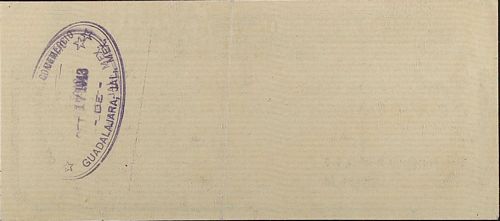
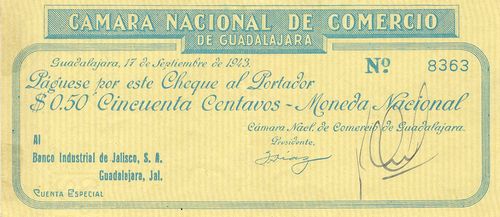
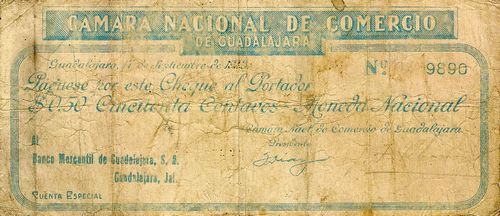
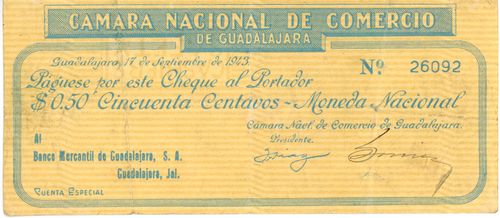
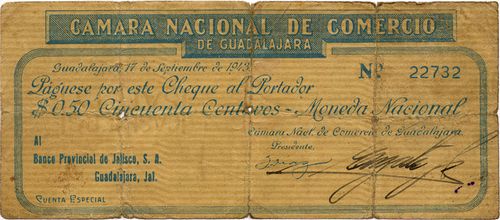
| drawn on | from | to | total number |
total value |
signature 1 (Presidente) |
signature 2 | |
| Banco Nacional de México | F. Díaz |
includes number 2862 | |||||
| Vázquez | includes number 28455 | ||||||
| Banco Refaccionario de Jalisco | Sada Paz | includes number 3305 | |||||
| includes number 7298 | |||||||
| Sada Paz | includes number 16977 | ||||||
| Banco Industrial de Jalisco | includes number 8363 | ||||||
| Banco Mercantil de Guadalajara | Pintado | includes number 9890 | |||||
| includes number 26092 | |||||||
| Banco Provincial de Jalisco | Arzate | includes number 22732 |
Each cheques had two signatures - Félix Díaz as the Presidente and one of the Consejeros: Efraín González Luna, Francisco de la Torre R., Ricardo Sada Paz, Manuel Martínez R., Salvador Uribe, Eduardo Toussaint, Mauricio Brun, Epifanio Arzate, Alfredo Vázquez, Ricardo Aguilar, J. Trinidad Ibarra, Marcelo Gasse, Miguel Moragrega, Enrique Vizcaino, Jesús Zuloaga and José PintadoEl Informador, Año XXVI, Tomo XCV, Núm. 9013, 7 September 1943.
|
His banking career began with the Banco Francés in Tampico, Tamaulipas. In 1927, on the recommendation of the Secretario de Hacienda Luis Montes de Oca, he moved to Guadalajara as director of the branch of the Banco de México. For more than ten years he worked in this position, living in the upper part of the offices of the Banco de México, located at the corner of calle 16 de Septiembre and calle Francisco I. Madero. As a promoter of independent banking, he was one of the founders of Banco de Zamora, Michoacán, which was established in that city in 1940. In Guadalajara, he supported the creation of the Banco Industrial de Jalisco, which began operating in November 1934. “Félix Díaz Garza distinguished himself by being a banker who changed the concept of traditional banking, towards a humanitarian approach, giving impetus to small businesses or people who wanted to start in a commercial or business branch. … A man of upright personality, congruent with his ideas and principles, he imposed respect and gave it to others, he supported all people equally, he developed a great social work at the head of various institutions: he was president of the National Chamber of Commerce of Guadalajara; also president of the Red Cross of Guadalajara; he also chaired the Instituto Jalisciense de Asistencia Social; promoted the creation of a club called "Sembradores de la Amistad (Sowers of Friendship)" seeking unity in families." He ordered the construction of a new building for the headquarters of the bank, which was inaugurated in May 1963, at the corner of calle September 16 and avenida Libertad, the work of the Austrian architect Erich E. Coufal. For Félix Díaz Garza this building of the bank that he founded represented one of his greatest achievements, of which he was very proud. He died on 4 December 1983 in the city of Guadalajara. |
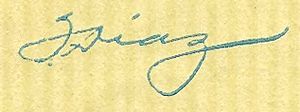 |
| Ricardo Aguilar | |
| Epifanio Arzate owned Refrescos Kist, which supplied soft drinks from a factory on calles República and Mariano Jiménez. | 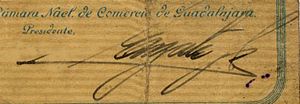 |
| Mauricio Brun | |
 Francisco de la Torre R. was involved in growing and distributing timber, and in 1965 his companies were Pinaster, S.A., Productos Forestales, S.A., Occidental Distribuidora, S.A.El Informador, Año XLIX, Tomo CLXXXV, Núm. 17,060, 8 October 1965. From 1966 to 1977 was on the board of the Banco de Comercio de Guadalajara. Francisco de la Torre R. was involved in growing and distributing timber, and in 1965 his companies were Pinaster, S.A., Productos Forestales, S.A., Occidental Distribuidora, S.A.El Informador, Año XLIX, Tomo CLXXXV, Núm. 17,060, 8 October 1965. From 1966 to 1977 was on the board of the Banco de Comercio de Guadalajara. |
|
|
Marcelo Gasse Gasse was a Frenchman, one of retail managers (jefes de menudeo) of "La Ciudad de México" from at least 1925El Informador, Año VIII, Tomo XXVII, Núm. 2,693, 9 April 1925 to 1936El Informador, Año XIX, Tomo LXXII, Núm. 6,823, 23 August 1936. He married Juanita Mariaud de Gasse. He died on 11 January 1968El Informador, Año LI, Tomo CXCIV, Núm. 17,884, 12 January 1968. |
|
|
He served as a professor of Law at the University of Guadalajara School of Law and at the Universidad Autónoma de Guadalajara. He also ran a law office from 1920, sponsoring and advising a large number of commercial and industrial concerns in Guadalajara and the west of the country. He was advisor and legal representative of the Banco Refaccionario de Jalisco S.A.; counselor of the Banco Provincial de Jalisco; legal representative of the Banco Nacional de México; consultant lawyer of the Chamber of Commerce of Guadalajara, and lawyer of the Archdiocese of Guadalajara. He authored a large number of literary, legal and political articles and essays, actively participated in editing the magazine Bandera de Provincias, and translated James Joyce and Franz Kafka. He was a co-founder of the Partido Acción Nacional, was a candidate for federal deputy in 1943 and 1946 and PAN’s first candidate for the Presidency in 1952, gaining 285,555 votes equivalent to 7.82 percent of the vote. He died on 10 September 1964 in Guadalajara as a result of a stroke. |
|
| Manuel Martínez R. | |
|
He died in Guadalajara on 11 October, 1969 at the age of 80 yearsEl Informador, Año LIII, Tomo CCI, Núm. 18,522, 13 October 1969. |
|
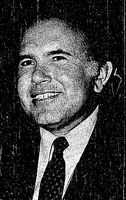 José Pintado was manager of the Guadalajara branch of the Banco Nacional de MéxicoEl Informador, Año XXIX, Tomo CVI, Núm. 9,975, 1 May 1946. He had already signed notes in 1935. José Pintado was manager of the Guadalajara branch of the Banco Nacional de MéxicoEl Informador, Año XXIX, Tomo CVI, Núm. 9,975, 1 May 1946. He had already signed notes in 1935. |
 |
|
Ricardo moved south and became a established industrialist and one of the “great and good “ of Guadalajara, as a members of organisations such as the Rotary Club, Lions, the Red Cross and Club Sembradores de Amistad. He was gerente of the Comercial de OccidenteEl Informador, Año XXIX, Tomo CVI, Núm. 9,975, 1 May 1946, connected with Monterrey since, as Gerente General of Comercio Occidental, he joined with Cristaleria, S.A., Vidrio Plano, S.A., Vidriera Mexico, S.A., Vidriera Monterrey, S.A., Vidrios y Cristales, S.A. in an advertisement congratulating the Nueva Ferretería Jalisciense on its inaugurationEl Informador, Año XXXII, Tomo CXIX, Núm. 11,193, 5 September 1949. In In September 1953 was gerente of the Vidrieria GuadalajaraEl Informador, Año XXXVI, Tomo CXXXV, Núm. 12,659, 11 September 1953, but resigned in April 1960 to move to MonterreyEl Informador, Año XLIII, Tomo CLXII, Núm. 15,077, 28 April 1960. In banking, he was on the Consejo Consultativo of the Banco Capitalizador de Monterrey in Guadalajara{footnote}El Informador, Año XXXVI, Tomo CXXXIII, Núm. 12,433, 28 January 1953 and in 10 November 1960 was on the Consejo Consultativo of the branch of Financiera del Norte. |
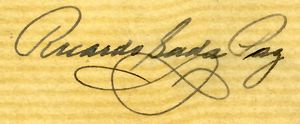 |
| Eduardo Toussaint | |
| J. Trinidad Ibarra | |
| Salvador Uribe | |
| Alfredo Vázquez | |
| Enrique Vizcaino | |
| Jesús Zuloaga | |
|
[ ]rez[identificaton needed] |
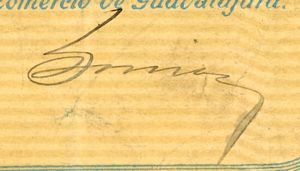 |
Another way to produce 50c notes was to split a $1 note in half. In Guadalajara the tram companies resorted to thisLa Opinión, Puebla, Año XIX, Tomo LVII, Núm. 6957, 7 September 1943.
Ciudad Guzmán
Mendoza y Compañía
In late August Guillermo Ochoa Mendoza, general manager of Mendoza y Compañía issued ten thousand 50c cheques drawn on the agency of the Banco Refaccionario de Jalisco, S. A. However, the cheques were printed on very poor paper and soon became unusableEl Informador, Año XXVI, Tomo LCV, Núm. 9004, 29 August 1943.
Cámara Nacional de Comercio
On 11 October the local Cámara Nacional de Comercio in Ciudad Guzmán decided to issue $5,000 in 50c chequesEl Informador, 13 October 1943. These were drawn on the Banco Refaccionario de Jalisco, S. A. and dated 18 October.
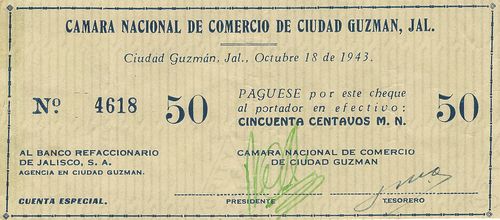
| from | to | total number |
total value |
||
| 50c | 1 | 9999 | 10,000 | $5,000 | includes number 4618 |
These are signed by [ ][identification needed] as Presidente and [ ][identification needed] as Tesorero.
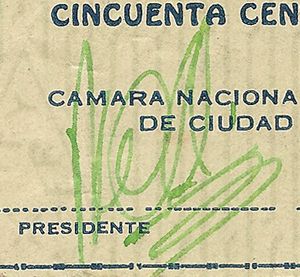 |
|
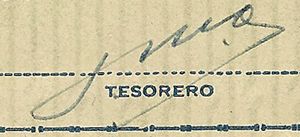 |
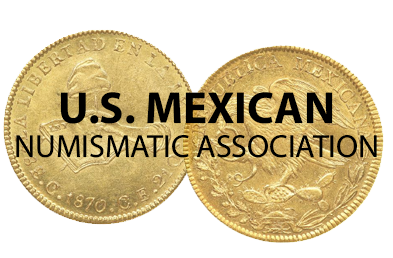
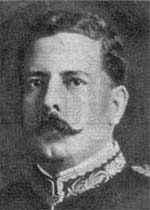 Félix Díaz Garza was born in Linares, Nuevo León on 24 August 1896.
Félix Díaz Garza was born in Linares, Nuevo León on 24 August 1896.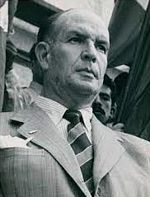 Efraín González Luna was born in Autlán, Jalisco on 18 October 1898, the grandson of Vicente Luna Corona, the owner of various haciendas in the south of the state.
Efraín González Luna was born in Autlán, Jalisco on 18 October 1898, the grandson of Vicente Luna Corona, the owner of various haciendas in the south of the state.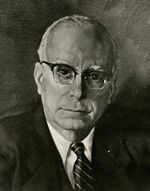 Miguel Moragrega Ollé was born on 8 May, 1889 in Barcelona, Spain, and came to Mexico at the age of 16. In 1916 he founded the Casa Moraguera, which was a shop for imported goods, and in the mid 1950s opened the first self-service food supermarket in Guadalajara, located between Chapultepec and Libertad. In the next three years he opened nine more supermarkets in the city, including the first “Maxi”, selling everything – food, clothing and footwear
Miguel Moragrega Ollé was born on 8 May, 1889 in Barcelona, Spain, and came to Mexico at the age of 16. In 1916 he founded the Casa Moraguera, which was a shop for imported goods, and in the mid 1950s opened the first self-service food supermarket in Guadalajara, located between Chapultepec and Libertad. In the next three years he opened nine more supermarkets in the city, including the first “Maxi”, selling everything – food, clothing and footwear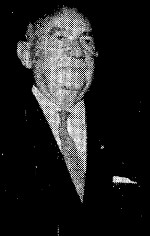 Ricardo Sada Paz was born on 2 April 1883, the son of
Ricardo Sada Paz was born on 2 April 1883, the son of